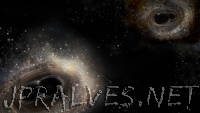
“The two LIGO gravitational wave detectors in Hanford Washington and Livingston Louisiana have caught a second robust signal from two black holes in their final orbits and then their coalescence into a single black hole. This event, dubbed GW151226, was seen on December 26th at 03:38:53 (in Universal Coordinated Time, also known as Greenwich Mean Time), near the end of LIGO’s first observing period (“O1”), and was immediately nicknamed “the Boxing Day event”. Like LIGO’s first detection, this event was identified within minutes of the gravitational wave’s passing. Subsequent careful studies of the instruments and environments around the observatories showed that the signal seen in the two detectors was truly from distant black holes – some 1.4 billion light years away, coincidentally at about the same distance as the first signal ever detected. The Boxing Day event differed from the LIGO’s first gravitational wave observation in some important ways, however.”
